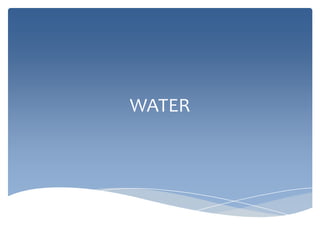
Water 1
- 1. WATER
- 2. 1. Water is essential constituent of all forms of life. 2. Water is present in every cell. It is the medium in which all cellular events occurs. 3. It is required for enzyme action and for the transport of solutes in the body. 4. Water aids the folding of biomolecules like proteins, nucleic acids etc. MEDICAL AND BIOLOGICAL IMPORTANCE
- 3. 5. Semi-fluid nature of body is due to water. 6. Water regulates body temperature. 7. Water accelerates biochemical reactions by providing ions. 8. Water content in the body alters in dehydration and edema.
- 4. Properties of Water Polarity Covalent bonds (electron pair is shared) between oxygen and hydrogen atoms with a bond angle of 104.5o
- 5. Oxygen atom is more electronegative that hydrogen atom -- > electrons spend more time around oxygen atom than hydrogen atom --> result is a POLAR covalent bond. Creates a permanent dipole in the molecule. Can determine relative solubility of molecules “like dissolves like”.
- 6. hydrogen bonds Due to polar covalent bonds --> attraction of water molecules for each other. Creates hydrogen bonds = attraction of one slightly positive hydrogen atom of one water molecule and one slightly negative oxygen atom of another water molecule.
- 7. The length of the bond is about twice that of a covalent bond. Each water molecule can form hydrogen bonds with four other water molecules. Weaker than covalent bonds (about 25x weaker).
- 8. Hydrogen bonds give water a high melting point. Density of water decreases as it cools --> water expands as it freezes--> ice results from an open lattice of water molecules --> less dense, but more ordered.
- 11. Hydrogen bonds contribute to water’s high specific heat (amount of heat needed to raise the temperature of 1 gm of a substance 1oC) - due to the fact that hydrogen bonds must be broken to increase the kinetic energy (motion of molecules) and temperature of a substance --> temperature fluctuation is minimal. Water has a high heat of vaporization - large amount of heat is needed to evaporate water because hydrogen bonds must be broken to change water from liquid to gaseous state.
- 12. universal solvent Water can interact with and dissolve other polar compounds and those that ionize (electrolytes) because they are hydrophilic. Do so by aligning themselves around the electrolytes to form solvation spheres - shell of water molecules around each ion. Solubility of organic molecules in water depends on polarity and the ability to form hydrogen bonds with water.
- 13. Functional groups on molecules that confer solubility: carboxylates protonated amines amino hydroxyl carbonyl As the number of polar groups increases in a molecule, so does its solubility in water.
- 14. hydrophobic interactions Nonpolar molecules are not soluble in water because water molecules interact with each other rather to nonpolar molecules --> nonpolar molecules are excluded and associate with each other (known as the hydrophobic effect).
- 15. Nonpolar molecules are hydrophobic. Molecules such as detergents or surfactants are amphipathic (have both hydrophilic and hydrophobic portions to the molecule).
- 16. Other noncovalent interactions in biomolecules 1) hydrogen bonds More important when they occur between and within molecules --> stabilize structures such as proteins and nucleic acids. 2) hydrophobic interactions Very weak. Important in protein shape and membrane structure.
- 17. 3) charge-charge interactions or electrostatic interactions (ionic bonds) Occur between two oppositely charged particles. Strongest noncovalent force that occurs over greater distances. Can be weakened significantly by water molecules (can interfere with bonding).
- 19. 4) van der Waals forces Occurs between neutral atoms. Can be attractive or repulsive ,depending upon the distance of the two atoms. Much weaker than hydrogen bonds. The actual distance between atoms is the distance at which maximal attraction occurs. Distances vary depending upon individual atoms.
- 20. Nucleophilic nature of water Chemicals that are electron-rich (nucleophiles) seek electron- deficient chemicals (electrophiles). Nucleophiles are negatively charged or have unshared pairs of electrons --> attack electrophiles during substitution or addition reactions. Examples of nucleophiles: oxygen, nitrogen, sulfur, carbon, water (weak).
- 21. Important in condensation reactions, where hydrolysis reactions are favored. e.g. protein ------> amino acids In the cell, these reactions actually only occur in the presence of hydrolases. Condensation reactions usually use ATP and exclude water to make the reactions more favorable.
- 22. Ionization of water Pure water ionizes slightly can act as an acid (proton donor) or base (proton acceptor).